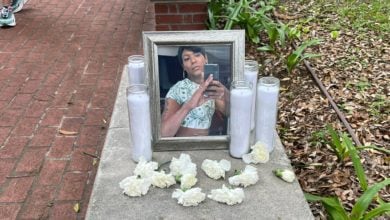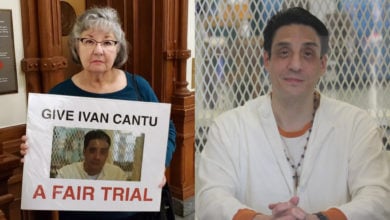The decades-long struggle to free Rodney Reed from death row has now reached the Supreme Court. Rodney Reed is a Black man who was convicted in 1998 of the rape and murder of Stacey Stites in Bastrop County, Texas. Since the trial, increasing evidence has come to light that Stites was likely murdered by her own fiancé, but Reed has been denied a new trial based on this evidence.
The Supreme Court has now heard oral arguments from Reed’s defense, demanding that proper DNA testing be conducted that could exonerate him. At the heart of the matter is an obscene question: Did Rodney Reed’s defense wait too long to request this DNA be tested? How long can an accused person request evidence of their own innocence before they are assumed forever to be guilty?
Reed’s conviction based on now-discredited evidence, faulty science
The prosecution built a narrative around the murder that is now contradicted by many expert analysts and new information.
The state of Texas’ entire case against Reed is based on selective use of DNA, highlighting some DNA evidence while refusing to test more relevant evidence that could contradict the prosecution’s claim. One of the key pieces of evidence against Reed was that his DNA was found in Stites’ body upon examination. Former coworkers and relatives of Stites, however, maintain that Reed and Stites had a consensual relationship while Stites was engaged to a Giddings, Texas, cop named Jimmy Fennell. The belt that was used to strangle Stites has never been tested for DNA.
The state of Texas argued that Stites was killed between 3 a.m. and 5 a.m. on April 23, 1996. But according to renowned forensic pathologist Michael Baden who testified in a 2017 hearing, Stites was actually killed before midnight on April 22. This timeframe was corroborated by two other leading experts and remains uncontradicted by the state. This is important because it means Stites would more likely have been in her own apartment, which she shared with Fennell, at the time she was murdered.
The state’s entire case against Reed is built on the presence of Reeds’ semen in Stites, but the reality is that this proves nothing about the murder. Department of Public Safety serologist Karen Blakley claimed that Reed’s intact spermatozoa meant that sperm could not have been left more than 26 hours before the examination, which would place Reed at the alleged time of the murder. However, in an affidavit admitting an error, Crime Lab Director Brady Mills testified that Blakley misstated the science. The presence of Reed’s sperm does not prove that Reed was at the crime scene, nor does it prove anything at all.
Prosecutors zero in on Reed while letting corrupt, abusive fiancé off the hook
Fennell was an initial suspect in Stites’s murder, but he managed to avoid further investigation. According to Bastrop Sheriff’s Officer Curtis Davis, a friend of Fennell, Fennell gave an inconsistent account of his location during the murder. Fennell told Davis that he was out drinking on the night of the murder, but later claimed he was with Stites in their apartment that night when, according to three forensic examiners, Stites was likely murdered. When asked to explain the discrepancy, Fennell declined to testify, asserting his Fifth Amendment right to avoid self-incrimination.
Aside from the logistical inconsistencies, multiple other witnesses have alleged that Fennell abused Stites and threatened her life. One such affidavit was filed by an unnamed life insurance agent who interacted with Fennell during a work function. At this event, the agent was assisting Stites with filling out a life insurance policy. Stites remarked, “I really don’t know why I need life insurance since I am so young.” The agent says that in response to that comment, “[Fennell], in my presence told her ‘if I ever catch you messing around on me, I will kill you and no one will ever know it was me that killed you.’ I remember it well because of the tone of voice that he used. It was not presented as a joke. That concerned me and still concerns me today, because I took it as a threat on her life.”
Other former cops have even claimed that Fennell made disparaging remarks about Stites at her own funeral. Jim Clampit, former deputy with the Lee County Sheriff’s Office, testified that Fennell said “something along the lines of ‘you got what you deserved,’” directing his comment at Ms. Stites’ body lying in the coffin. Cynthia Schmidt, former Giddings dispatcher, also testified that Fennell said “at least the b***h got to wear the damn dress,” referring to Stites being buried in what would have been her wedding dress.
There were multiple indicators that Fennell and Stites’ relationship was abusive. Susan Hugen, one of Stites’ former coworkers, testified that she saw hand marks on Stites’ wrists. Hugen said she believed that Stites was in an abusive relationship because she herself was once in one and recognized the signs.
Retired FedEx worker Richard Scroggins testified that he witnessed Fennell screaming obscenities at Stites in an HEB parking lot in 1996. According to Scroggins’ testimony, Fennell was yelling, “You lying, f***ing b***h, lying f***ing c**t.” Scroggins was apparently so shocked that he was “paralyzed by the screaming that lasted for a couple of minutes.” Fennell eventually turned to Scroggins and said, “What are you f***ing looking at, little man? This is none of your f***ing business.”
These disparaging statements and abusive behavior are damning enough, but Fennell may have even confessed to Stites’ murder while in prison.
Arthur J. Snow Jr., a former member of the Aryan Brotherhood, spent some time with Fennell in prison in Cuero, Texas, where Fennell was serving time for the on-duty rape of a woman. Fennell allegedly sought protection from the Aryan Brotherhood while in prison. After an initial deal to keep other groups in the prison off of his back and protect him from violence, the two struck up a conversation one day regarding Stites. Snow testified in an affidavit that Fennell was “talking about his ex-fiancé with a lot of hatred and resentment. [Fennell] said his fiancé had been sleeping around with a Black man behind his back. By the way [Fennell] spoke about this experience, I could tell that it deeply angered him. Towards the end of the conversation, [Fennell] said confidently, ‘I had to kill my n****r-loving fiancé.’”
Later, Snow saw Fennell’s face in a newspaper alongside Reed’s in an article about the murder. According to Snow, that’s when the facts “came together” for him. His affidavit continued, “I recalled my conversation in the rec yard with [Fennell]. I realized that Rodney Reed was sitting in prison for a murder that Jimmy Fennell had confessed to me that he had committed.”
Long appeals system has exposed the courts’ disregard for human suffering
The Supreme Court is essentially hearing the Reed case as a procedural question, regardless of human consequence.
Reed’s defense has been trying to have the DNA of the murder weapon tested for many years. The state has maintained that the murder weapon should not be tested because it was improperly stored. A district court seconded this decision, denying Reed this right in 2014. The Texas Criminal Court of Appeals upheld the lower court’s ruling in 2017.
In 2019, as Reed’s execution date was approaching, his defense filed a federal claim under Section 1983, which allows individuals to sue state actors for violating their rights. The state is claiming that the two-year statute of limitations began in 2014.
Reed was convicted on one piece of DNA evidence, which was falsely presented to the jury as a “smoking gun,” while an actual “smoking gun” — the belt that was used to strangle Stites — sits in an evidence room untested year after year.
The Supreme Court could end this nonsense at any time if it affirms that accused people have a right to test evidence that could exonerate them regardless of statutes of limitations. Even if it rules in Reed’s favor, the decade-long ordeal of court appeals has exposed just how little these institutions care about the human cost of their procedural rulings.





